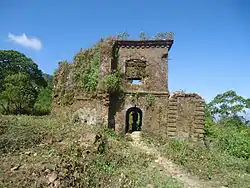Battle of Sindhuli
The Battle of Sindhuli (Nepali: सिन्धुलीको युद्ध; also known as the Battle of Sindhuli Gadhi) was fought on 6 November 1767 near Sindhuli Gadhi. The battle was part of the unification of Nepal led by Prithvi Narayan Shah, King of Gorkha (later King of Nepal).
| Battle of Sindhuli | |||||||
|---|---|---|---|---|---|---|---|
| Part of the Unification of Nepal | |||||||
 The ruins of Sindhuli Gadhi | |||||||
| |||||||
| Belligerents | |||||||
|
|
Kingdom of Kantipur | ||||||
| Commanders and leaders | |||||||
| Prithvi Narayan Shah |
Jaya Prakash Malla Captain Kinloch | ||||||
 Sindhuli Gadhi Location within Nepal | |||||||
Background
Unification campaign
Before the unification, Nepal was divided into many various petty kingdoms, notability Baise rajyas (22 kingdoms) in the west,[2] Chaubisi Rajyas (24 kingdoms) in the Gandaki region,[3] Malla Kingdoms in the Kathmandu Valley,[2] and other kingdoms to extending to Sikkim.[4] Gorkha, an Independent kingdom in Gandaki, was founded in 1559 by Dravya Shah, the second son of Yasho Brahma Shah, King of Kaski and Lamjung.[5] In 1739, King Nara Bhupal Shah, launched a attack on Nuwakot, a territory controlled by Malla kings and Gorkhalis lost the war.[6] Once again, he launched another attack with help from Kantipur and Patan(now known as Kathmandu, and Lalitpur respectively), and Gorkhas were ultimately defeated.[6]
On 3 April 1743,[7] 20-year-old, Prithvi Narayan Shah ascended the throne of the Gorkha after the death of his father Nara Bhupal Shah.[6] Like his father, he attacked Nuwakot in 1742 and he suffered another defeat so Shah realised he needed more military technology and manpower to capture Nuwakot.[8] Shah acquired weapons from Banaras, created alliances with other kingdoms, increased the manpower, and started the assault on 26 September 1744.[9] This time Gorkhalis won the war which resulted in Nuwakot ceding from Malla Kings and subsequently started the unification of Nepal campaign.[10] As Gorkhas were continuing their expansion, Jaya Prakash Malla, King of Kantipur requested assistance from the East India Company because he did not see other ways to stop them.[11] Thomas Rumbold, head of the company in Patna advised Shah to remove the blockade of Kantipur and abstain from attacking Malla or else it could result in a war.[11] Rumbold not receiving any positive response from Prithvi Narayan Shah led to the Battle of Sindhuli.[11]
Trade route
During the reign of Gorkha's Ram Shah and Kantipur's Pratap Malla, both gained control of important areas in Tibet's border crossing areas where most of the trans-Himalayan trade occurred.[12] Shah invaded Tibet around c. 1625-1630, the first attack was unsuccessful however the second strike proved to be successful which gained control of Kerong and went far as Kukurghat, north of Kerong.[12] War ended with Gorkha signing a treaty with Tibet which gave Shah access to the main trade route.[12] This created a problem for Kantipur as their traders used the same route, Malla did not fight for Kerong but he gained access to Kuti, second important route.[12] He also signed a treaty, which created a monopoly for their traders as the trade between India and Tibet was extremely profitable, and the king also profited from the coins minted for their government.[12] East India Company carried their trades to Tibet and China from Kathmandu, and they came in conflict with the Gorkhas because Prithvi Narayan Shah's blockade of Kantipur which affected them.[13][14]
Terrain
Sindhuli Gadhi is located 4,648 feet above the sea level and it is about 150-kilometre away from Kathmandu.[15]
References
Citations
- "पृथ्वीनारायण शाहद्वारा स्थापित पाँच सैन्य एकाइ कुन हुन् र अहिले कहाँ छन्". BBC News (in Nepali). Retrieved 26 January 2021.
- Shrestha 2017, p. 66.
- Bista 1991, p. 44.
- Subba 2008, p. 386.
- Rana 2018, p. 1.
- Sinha 2018, p. chapter 2.
- Shrestha 1997, p. 6.
- Hamal 1995, p. 176.
- Hamal 1995, p. 97.
- Hamal 1995, p. 99.
- Hamal 1995, p. 116.
- Rose 1971, p. 13.
- Basnyat, Prem Singh. "The battle of Sindhuli". My Republica. Retrieved 25 January 2021.
- Waller 2014, p. 171.
- Basnet, Rakshya. "Sindhuli Gadhi: History that deserves to be remembered". My Republica. Retrieved 26 January 2021.
Bibliography
- Bista, Dor Bahadur (1991). Fatalism and Development: Nepal's Struggle for Modernization. Orient Blackswan. p. 44. ISBN 978-81-250-0188-1.
- Shrestha, Nanda R. (8 February 2017). Historical Dictionary of Nepal. Rowman & Littlefield. ISBN 978-1-4422-7770-0.
- Subba, J. R. (2008). History, Culture and Customs of Sikkim. Gyan Publishing House. ISBN 978-81-212-0964-9.
- Rana, Ramji (14 October 2018). "CoAS Thapa unveils statute of 16th-century monarch Yasho Brahma Shah". The Himalayan Times. Retrieved 18 January 2021.
- Sinha, Awadhesh C. (26 October 2018). Dawn of Democracy in the Eastern Himalayan Kingdoms: The 20th Century. Taylor & Francis. ISBN 978-0-429-68568-2.
- Shrestha, Nanda R. (1997). In the Name of Development: A Reflection on Nepal. University Press of America. ISBN 978-0-7618-0759-9.
- Hamal, Lakshman B. (1995). Military History of Nepal. Sharda Pustak Mandir.
- Pradhan, K. L. (2012). Thapa Politics in Nepal: With Special Reference to Bhim Sen Thapa, 1806-1839. Concept Publishing Company. ISBN 978-81-8069-813-2.
- Rose, Leo E.; Studies, University of California, Berkeley Center for South and Southeast Asia (1971). Nepal; Strategy for Survival. University of California Press. ISBN 978-0-520-01643-9.
- Waller, Derek (11 July 2014). The Pundits: British Exploration of Tibet and Central Asia. University Press of Kentucky. ISBN 978-0-8131-4904-2.